


| Brangwyn art in #s 3,6,7 & 10 of |
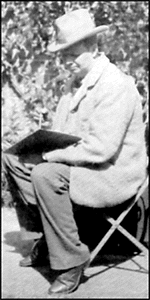 Frank
Brangwyn was born in 1867 in Bruges, Belgium. His family moved
back to London in 1875 where he attended school until 1879, when
he left as much out of boredom as necessity. His father worked
as an architect, muralist, and in other arts-related crafts. Frank
helped around the studio and continued his own artistic education
by copying drawings at what was to become the Victoria and Albert
Museum. His abilities attracted the notice of more established
artists and at the age of 15 he was working for William Morris
getting rudimentary training and preparing designs for many aspects
of Morris' Arts and Crafts output. In 1885, with nothing much
more than youthful enthusiasm, he submitted a painting to the
Royal Academy Summer Exhibition and was accepted - at the age
of 17. Spurred by this success he rented a studio and began a
period of productive poverty.
Frank
Brangwyn was born in 1867 in Bruges, Belgium. His family moved
back to London in 1875 where he attended school until 1879, when
he left as much out of boredom as necessity. His father worked
as an architect, muralist, and in other arts-related crafts. Frank
helped around the studio and continued his own artistic education
by copying drawings at what was to become the Victoria and Albert
Museum. His abilities attracted the notice of more established
artists and at the age of 15 he was working for William Morris
getting rudimentary training and preparing designs for many aspects
of Morris' Arts and Crafts output. In 1885, with nothing much
more than youthful enthusiasm, he submitted a painting to the
Royal Academy Summer Exhibition and was accepted - at the age
of 17. Spurred by this success he rented a studio and began a
period of productive poverty.
 With
little money, his early work revolved around the sea where traditional
subjects for British art were moored and made docile models. This
is considered his "grey" period and the limited palette
may be due as much to limited funds as to artistic intent. His
1890 canvas, Funeral At Sea (at left) is typical
of this period and won a gold medal at the 1891 Paris Salon. The
young artist was making waves.
With
little money, his early work revolved around the sea where traditional
subjects for British art were moored and made docile models. This
is considered his "grey" period and the limited palette
may be due as much to limited funds as to artistic intent. His
1890 canvas, Funeral At Sea (at left) is typical
of this period and won a gold medal at the 1891 Paris Salon. The
young artist was making waves.
 In
1888, he worked on a freighter for passage to the Near East of
Istanbul and the Black Sea. Orientalism was a major force in European
art at the time and Brangwyn was as seduced as many artists were
with the colors and light of the Mediterranean and African coasts.
These trips brought a new palette to his work and something new
to British art. The Buccaneers, at right, is from
1892 and the difference between it and his "grey" period
is dramatic.
In
1888, he worked on a freighter for passage to the Near East of
Istanbul and the Black Sea. Orientalism was a major force in European
art at the time and Brangwyn was as seduced as many artists were
with the colors and light of the Mediterranean and African coasts.
These trips brought a new palette to his work and something new
to British art. The Buccaneers, at right, is from
1892 and the difference between it and his "grey" period
is dramatic.
Just as we have movie critics today, art critics proliferated
during the 19th century. Walter Shaw Sparrow, in his excellent
Frank Brangwyn and His Work, devotes several chapters to
the reaction of these critics to Brangwyn's art. Opinions were
as varied as the two styles shown here, but what is most interesting
is the degree of attention being paid to the work of a self-taught
25-year old. Whatever their views of his work, he was not being
taken lightly. Not surprisingly, the bright hues and intense light
of his new style were not appreciated by the establishment.
To put his work in historic perspective, this was a period of Impressionism, Art Nouveau, and the Munich and Vienna Secessions. In British art, Sargent, Whistler, Waterhouse and Draper were popular. Lord Leighton, Burne-Jones and Alma-Tadema were still active. Brangwyn was following none of these men and the critics were at a loss as to how to pigeonhole him. The continental critics in France, Munich and Vienna had no such trouble. He was seen as a most modern and successful artist from the beginning. For his part, Brangwyn followed his own muse and in doing so found himself at the vanguard of the art world. In 1892 he began working as the designer for the new art magazine, The Graphic. In 1895 he was asked to paint murals for the notorious gallery, L'Art Nouveau, in Paris. He won medals for his work in Munich and Paris. At the age of 30, while Britain puzzled over how to evaluate his work, the rest of the world viewed him as the definition of modern British art.
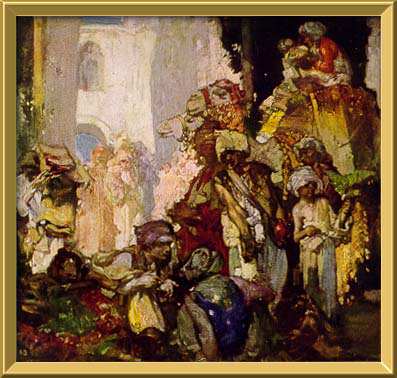 Brangwyn
was the consummate artist.
Brangwyn
was the consummate artist.
- He illustrated books: Don Quixote in 1895, A Spliced Yarn in 1899, The Spirit of the Age in 1905, The Last Flight of the Revenge in 1908, a Rubaiyat in 1909 and Eothen in 1913 (with paintings dated from 1896 and 1897 - see larger image at right).
- His illustrations found eager audiences in the American magazines. Scribners ran his illustrations as early as 1893, recognizing his talent before many of his countrymen. Both The Century and McClures were markets as well - though much later.
- He worked in watercolor - when The Studio started a series of Famous Water-Colour Painters, Frank Brangwyn was the lead-off title.
 He revelled
in etchings, doing hundreds on a wide variety of subjects. When
The Studio started their series of Famous Etchers,
you-know-who was #1 (and one of only two artists to be given
two volumes). In 1926, The Studio published The Etchings
of Frank Brangwyn - a catalogue raisonne, with reproductions
of over 330 etchings. Like pen and ink work, etchings do not
reproduce well in small size on the web. If you'd like to see
details of one of his plates, click the small image at right
for a full-sized version.
He revelled
in etchings, doing hundreds on a wide variety of subjects. When
The Studio started their series of Famous Etchers,
you-know-who was #1 (and one of only two artists to be given
two volumes). In 1926, The Studio published The Etchings
of Frank Brangwyn - a catalogue raisonne, with reproductions
of over 330 etchings. Like pen and ink work, etchings do not
reproduce well in small size on the web. If you'd like to see
details of one of his plates, click the small image at right
for a full-sized version.- He painted murals: his most famous being those for Skinners
Hall, the 1915 Panama-Pacific Exhibition in San Francisco,
and the British Empire Panels for the House of
Lords. After completion, these sumptuous panels were rejected
by the House of Lords and were never installed.
There's also an American connection with the mural work of Dean Cornwell. At the same time that Brangwyn was working on the Empire Panels, Cornwell had won a commission to create the murals for the Los Angeles Public Library. In 1927, Cornwell put his illustration career on hold for three years and went to England to study and work with Brangwyn, who had the space and tools to create murals of any size.
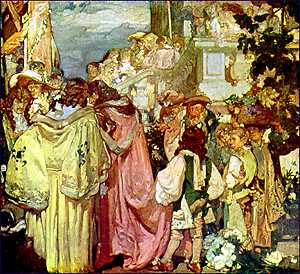
|
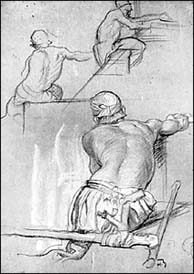
|
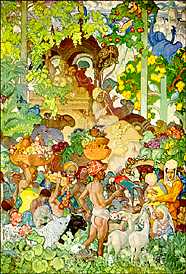
|
| Skinners Hall - 1902 | Skinners Hall - 1902 | British Empire Panels - 1930 |
- He drew - most often overlooked in the rush to lionize his paintings and etchings are the marvelous and powerful preparatory drawings that preceded them all. Books like The Prints and Drawings of Frank Brangwyn and The Drawings of Sir Frank Brangwyn, R.A. do much to remedy that oversight. Above center is one of the preliminary studies for a panel of the Skinners Hall murals.
- He practiced the lessons he'd learned from William Morris and produced designs for the "decorative arts" - wallpaper, stained glass, furniture, lamps, even the interior of The Empress of Britain, a luxury ocean liner (sadly his realized vision was torpedoed in WWII). A portion of the dining room is shown below - from a 1930 issue of The Studio. The Decorative Art of Frank Brangwyn is a testament to his variety.
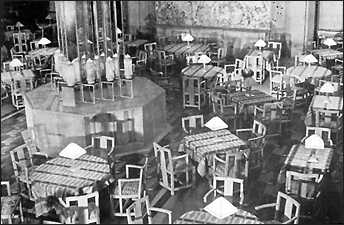
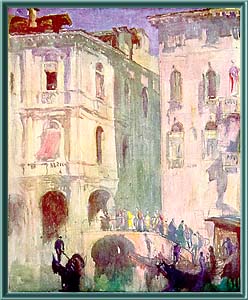 Brangwyn's
talent was never bounded by one or two facets. He illustrated
two books on bridges, a subject of many of his paintings and etchings.
The Bridge and A Book of Bridges are two different
books. He was also fascinated with windmills and illustrated a
book on that subject as well. He loved Venice. The Pageant
of Venice from 1922 was the natural result. (See the image
at left - which doubles as a sample of his watercolor technique.)
Belgium was the subject of another history. His bookplates
were collected into yet another volume.
Brangwyn's
talent was never bounded by one or two facets. He illustrated
two books on bridges, a subject of many of his paintings and etchings.
The Bridge and A Book of Bridges are two different
books. He was also fascinated with windmills and illustrated a
book on that subject as well. He loved Venice. The Pageant
of Venice from 1922 was the natural result. (See the image
at left - which doubles as a sample of his watercolor technique.)
Belgium was the subject of another history. His bookplates
were collected into yet another volume.
Two fascinating "biographies" of Brangwyn were written by William de Belleroche: Brangwyn Talks and Brangwyn's Pilgrimage. Both are extracted from numerous discussions and interviews with the artist. Pilgrimage is dotted with vibrant new drawings and both present the personality and history of FB in a fresh and vital manner.
Brangwyn died in 1956, an all-but-forgotten footnote in the history of art. His influence is still being felt today, albeit mainly third or fourth hand through artists who may not even know his name.
An interesting sidenote: In all the books by and about Brangwyn, I couldn't find a single image that contained his signature! Several were initialled, but nowhere was a sample to use for the heading of this page. I finally found his name in his design for the title page of The Girl and The Faun and used that. But I think it bespeaks volumes about his self-esteem that he didn't feel the need to plaster his name over everything he did. His style, in all his varied media, is all the signature he ever needed.
New from Auad Publishing
A beautiful and faithful reprint of the 1935 Brangwyn Portfolio
The Way of the Cross. Postpaid in the U.S. for less than $75.
Letterpress on 80 lb laid ivory in a custom, embossed folio. Highly
Recommended!

To learn more about Frank Brangwyn, see:
| Frank Brangwyn and His Work | Walter Shaw Sparrow, 1910 Kegan, Paul, Trench, Tubner |
| The Decorative Art of Frank Brangwyn | Herbert Furst, 1924 Dodd Mead |
| Brangwyn's Pilgrimage | William de Belleroche, 1948 Chapman & Hall |
| Collectie Frank Brangwyn | Dominique Marechal, 1987 Generale Bank |
| The Vadeboncoeur Collection of Knowledge | Jim Vadeboncoeur, Jr. 1999 |
| The Vadeboncoeur Collection of ImageS 3, 6, 7, 10 | Jim Vadeboncoeur, Jr. 2002-2008 |
|
Illustrations are copyright by their
respective owners. This page written, designed & © 1999 by Jim Vadeboncoeur, Jr. Updated 2011. |
